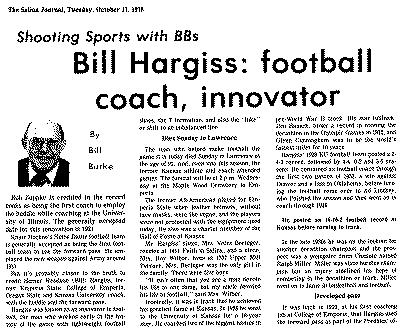|
|
Bill Hargiss: football coach, innov ator
ator
Salina Journal, October
17, 1978
by Bill Burke
Bob Zuppke is credited in the record books as being the
first coach to employ the huddle while coaching at the University of Illinois. The
generally accepted date for this innovation is 1921.
Knute Rockne's Notre Dame football team is generally accepted
as being the first football team to use the forward pass. He employed the new weapon
against Army around 1913.
But it's probably closer to the truth to credit Homer Woodson
(Bill) Hargiss, former Emporia State, College of Emporia, Oregon State and Kansas
University coach, with the huddle and the forward pass.
Hargiss was known as an innovator in football, the man
who worked early in the history of the game with lightweight football shoes, the
T formation, and also the "hike" or shift to an unbalanced line.
Dies Sunday in Lawrence
The man who helped make
football the game it is today died Sunday in Lawrence at the age of 91. And, even
into this season, the former Kansas athlete and coach attended games. The funeral
will be at 2 p.m. Wednesday at the Maple Wood Cemetery in Emporia.
The former All-American played for Emporia State when leather
helmets, without face masks, were the vogue, and the players were not protected
with the equipment used today. He also was a charter member of the Hall of Fame
at Kansas.
Mr. Hargiss' sister, Mrs. Vetra Beringer, resides at 1411
Faith in Salina, and a niece, Mrs. Roy Wilbur, lives at 1707 Upper Mill Terrace.
Mrs. Beringer was the only girl in the family. There were five boys.
"It isn't often that you see a man devote his life to one
thing, but my uncle devoted his life to football," said Mrs. Wilbur.
Ironically, it was in track that he achieved his greatest
fame at Kansas. In 1928 he went to the University of Kansas for a 16-year ,stay.
He coached two of the biggest names in pre-World War II track. His star fullback,
Jim Bausch, broke a record in winning the decathlon in the Olympic Games in 1932,
and Glenn Cunningham was to be the world's fastest miler for 10 years.
Hargiss' 1928 KU football team posted a 2-4-2 record, followed
by 4-4, 6-2 and 5-5 seasons. He remained as football coach through the first two
games of 1932, a win against Denver and a logs to Oklahoma, before turning the football
reins over to Ad Lindsey, who finished the season and then went on to coach through
1938.
He posted an 18-16-2 football record at Kansas before
turning to track.
In the late 1930s he was
on the lookout for another decathlon champion and the prospect was a youngster from
Chanute named Ralph Miller. Miller was state hurdles champion but an injury sidelined
his hope of competing in the decathlon or track. Miller went on to fame in basketball
and football.
Developed pass
It was back in 1910, at his first coaching job at College of Emporia, that Hargiss
used the forward pass as part of the Presbies' offense. That was three years before
the Irish used it against Army.
It was with the Oregon State Beavers football team in 1918
that many believe the huddle was used for the first time.
The team didn't have much of a record, 2-4, and played such
teams as Vancouver Barracks, Standifer Shipbuilders, Camp Lewis and Multnomah Athletic
Club, in addition to Oregon and Washington.
But it was that team that Hargiss coached that flirted
with the College Hall of Fame at Rutgers University by using the huddle.
Hargiss arrived in Corvallis in the fall of 1918 after coaching Emporia State, then
known as Kansas State Normal College of Emporia.
The Beavers were having trouble moving the ball against
Washington University in Seattle Nov. 18, 1918. In those days the teams simply lined
up and called signals on the line. The opposition could hear the calls and Washington
players understood the calls.
Jack J. Foster, a right end from The Dalles, Ore., says
he's sure the huddle was used in the game, although it was not given the name at
the time.
"Washington was reading our signals the first half and
stopped us cold," Foster remembers. "So, during halftime Coach Hargiss told us to
whisper the play out of hearing of the defensive team, and then our plays began
to work. We did not use it on every play. So, I am sure that Coach Bill Hargiss
was the very first to use the huddle. " Oregon State won that game, 6-0.
Hargiss later related that he got the huddle idea several
years before when he watched some boys play an unorganized scrimmage. They didn't
have a signal system but whispered their plays.
Hargiss, who also coached track, left Oregon State after
two years to return to Emporia State and in eight years was successful both in football
and track. His 1926 Emporia State football team was undefeated, untied and did not
give up a touchdown. But a three-point field goal was scored against E-State.
And it was from there he went on to further fame at Kansas.
Later he became a coach of Olympic athletes and coached the Olympic teams until
he was nearly 80.
"He gave things to the game, he gave his life to football,"
Mrs. Wilbur said.